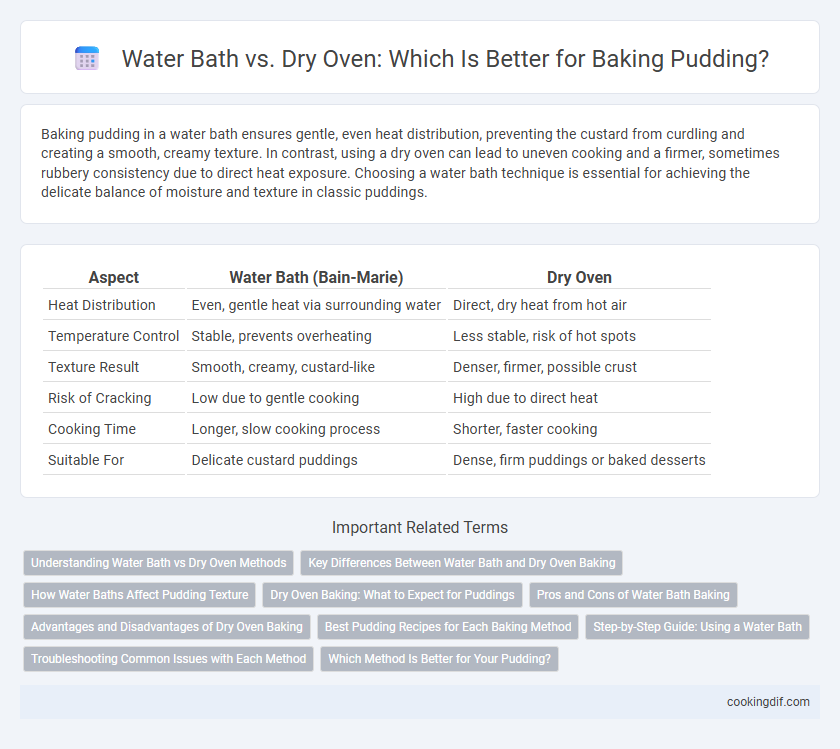Baking pudding in a water bath ensures gentle, even heat distribution, preventing the custard from curdling and creating a smooth, creamy texture. In contrast, using a dry oven can lead to uneven cooking and a firmer, sometimes rubbery consistency due to direct heat exposure. Choosing a water bath technique is essential for achieving the delicate balance of moisture and texture in classic puddings.
Table of Comparison
| Aspect | Water Bath (Bain-Marie) | Dry Oven |
|---|---|---|
| Heat Distribution | Even, gentle heat via surrounding water | Direct, dry heat from hot air |
| Temperature Control | Stable, prevents overheating | Less stable, risk of hot spots |
| Texture Result | Smooth, creamy, custard-like | Denser, firmer, possible crust |
| Risk of Cracking | Low due to gentle cooking | High due to direct heat |
| Cooking Time | Longer, slow cooking process | Shorter, faster cooking |
| Suitable For | Delicate custard puddings | Dense, firm puddings or baked desserts |
Understanding Water Bath vs Dry Oven Methods
The water bath method provides gentle, even heat by surrounding the pudding with hot water, preventing curdling and promoting smooth, creamy texture. In contrast, a dry oven uses direct, dry heat that can cause uneven cooking and a firmer, less delicate consistency. Choosing a water bath is essential for custard-based puddings to maintain moisture and achieve the ideal silky finish.
Key Differences Between Water Bath and Dry Oven Baking
Water bath baking maintains consistent, gentle heat and high humidity, preventing custards and puddings from curdling and cracking, which results in a smoother texture. Dry oven baking exposes dishes to direct, dry heat that cooks faster but can cause uneven temperature distribution and surface dryness, potentially leading to a firmer, less creamy pudding. The choice between water bath and dry oven depends on the desired pudding texture and moisture retention during baking.
How Water Baths Affect Pudding Texture
Water baths create a gentle, even heat that prevents puddings from curdling, resulting in a smoother and creamier texture. The moisture in the water bath helps regulate temperature and reduces the risk of edges overcooking while the center remains undercooked. In contrast, dry ovens can produce a firmer, less uniform pudding with potential cracks due to direct heat exposure.
Dry Oven Baking: What to Expect for Puddings
Dry oven baking for puddings typically results in a firmer texture with a golden, slightly crisp exterior due to the direct, dry heat that promotes surface caramelization. Unlike water bath baking, which ensures gentle and even cooking, the dry oven method requires careful temperature control to prevent overbaking or uneven cooking in the pudding's center. Expect a richer flavor profile as Maillard reactions intensify, but be prepared for less creamy consistency compared to the moist environment of a water bath.
Pros and Cons of Water Bath Baking
Water bath baking ensures even heat distribution, preventing the pudding from cracking or curdling by maintaining a consistent, moist environment. This method can be time-consuming and requires careful water level monitoring to avoid spills or overflows. Unlike dry oven baking, it yields a silky texture but might result in longer cooking times and less browning.
Advantages and Disadvantages of Dry Oven Baking
Dry oven baking offers a more consistent and higher temperature environment, which can result in a firmer texture and caramelized surface on puddings. However, it lacks the moisture retention provided by a water bath, increasing the risk of overbaking and cracked surfaces. This method is particularly advantageous for recipes that require browning but may lead to dryness or uneven cooking in delicate custard-based puddings.
Best Pudding Recipes for Each Baking Method
Water bath baking ensures gentle, even heat, perfect for creamy, delicate puddings like classic creme brulee and flan, preventing curdling and cracked surfaces. Dry oven baking suits denser, firmer puddings such as bread pudding or steamed Christmas pudding, providing a caramelized top and rich texture. Choosing the right method enhances flavor and texture based on pudding type and recipe requirements.
Step-by-Step Guide: Using a Water Bath
Place the pudding mold inside a larger pan filled with hot water reaching halfway up the mold to ensure even heat distribution. Bake at a consistent temperature, typically around 325degF (163degC), while monitoring water levels to prevent drying out. This gentle cooking method prevents cracking and produces a smooth, creamy texture in the pudding.
Troubleshooting Common Issues with Each Method
Water bath baking ensures even heat distribution, preventing puddings from cracking or drying out, but improper sealing can cause water to seep in and affect texture. Dry oven baking may result in uneven cooking or overly browned edges, often caused by fluctuating oven temperatures or lack of moisture. To troubleshoot, use a reliable thermometer for consistent heat and wrap the pudding container tightly to maintain moisture in either method.
Which Method Is Better for Your Pudding?
Baking pudding in a water bath ensures even heat distribution, preventing the edges from overcooking while maintaining a creamy, smooth texture ideal for custard-based puddings. Dry oven baking exposes the pudding to direct heat, which can cause cracking or uneven cooking but works well for firmer, denser puddings. For optimal results, choose a water bath method to preserve moisture and achieve a delicate consistency essential for classic pudding recipes.
Water bath vs dry oven for baking Infographic

 cookingdif.com
cookingdif.com